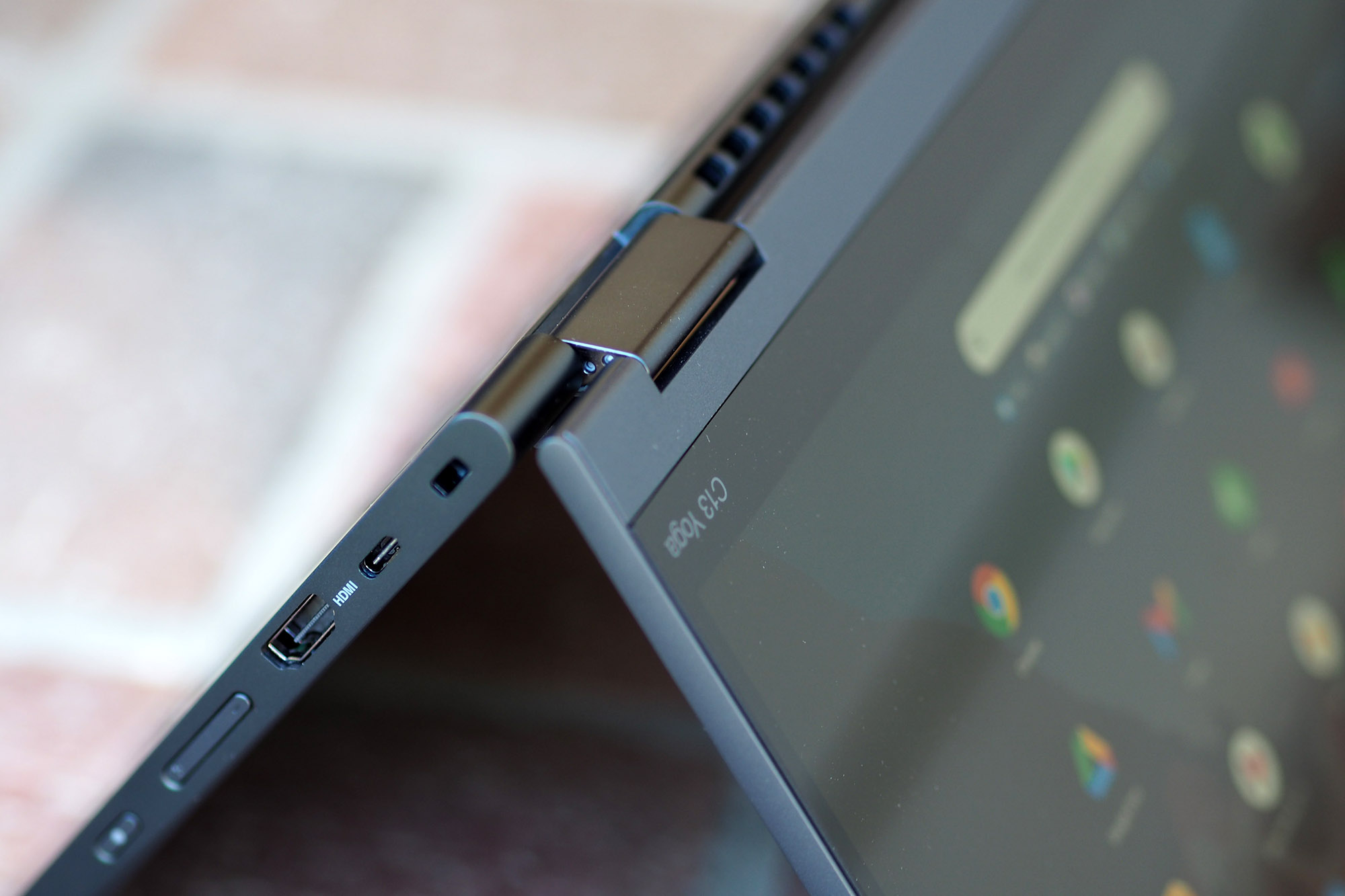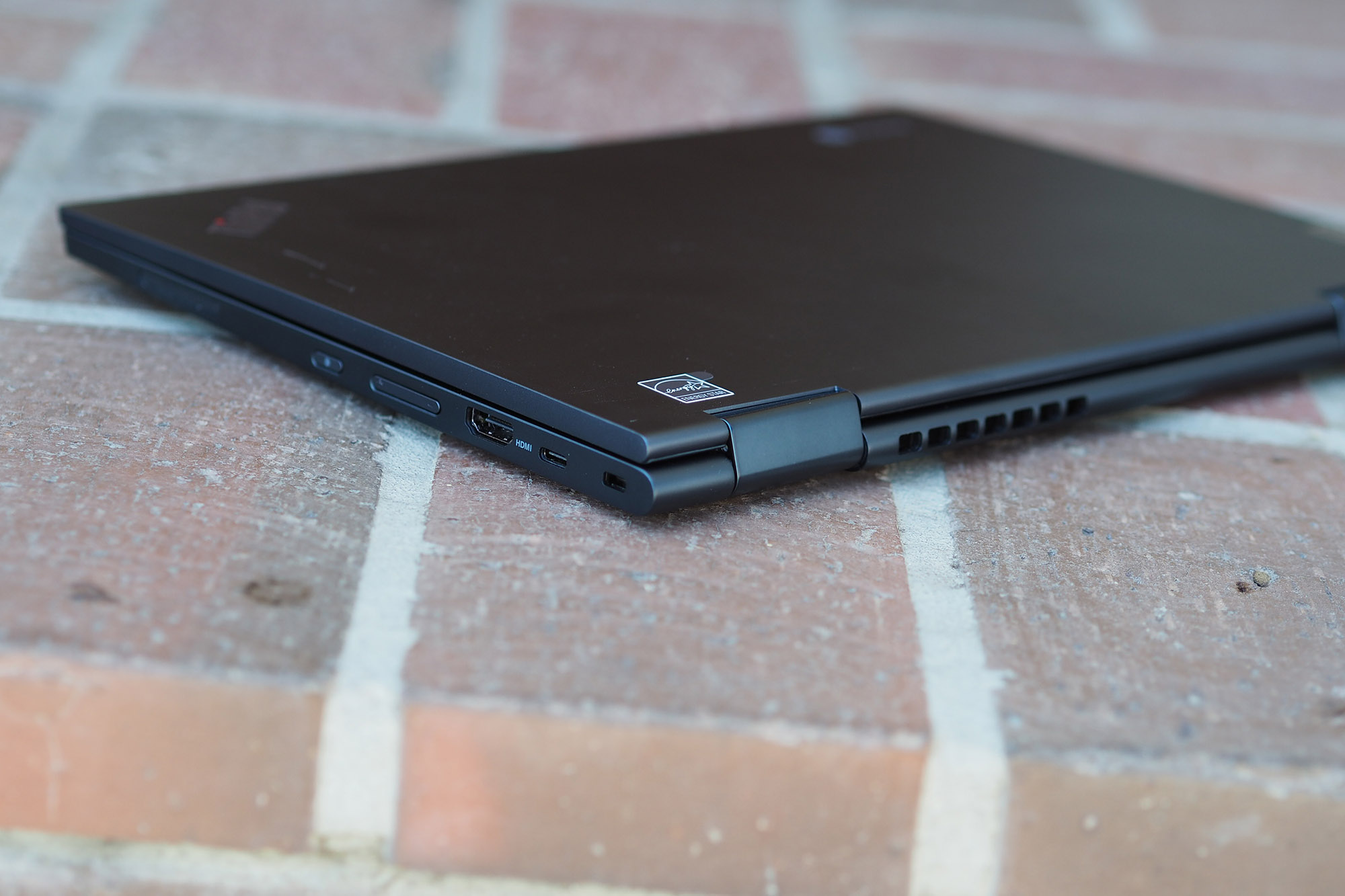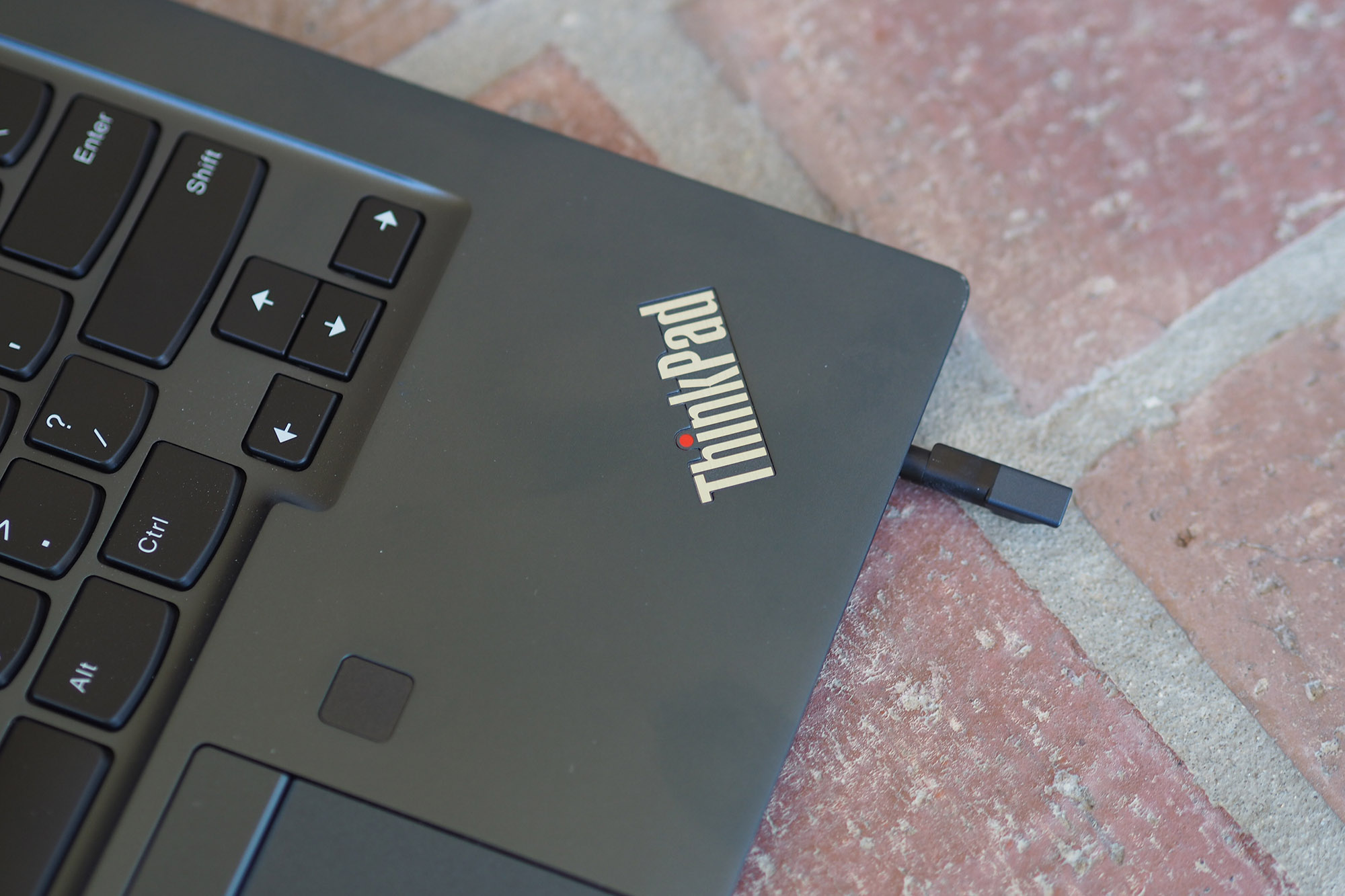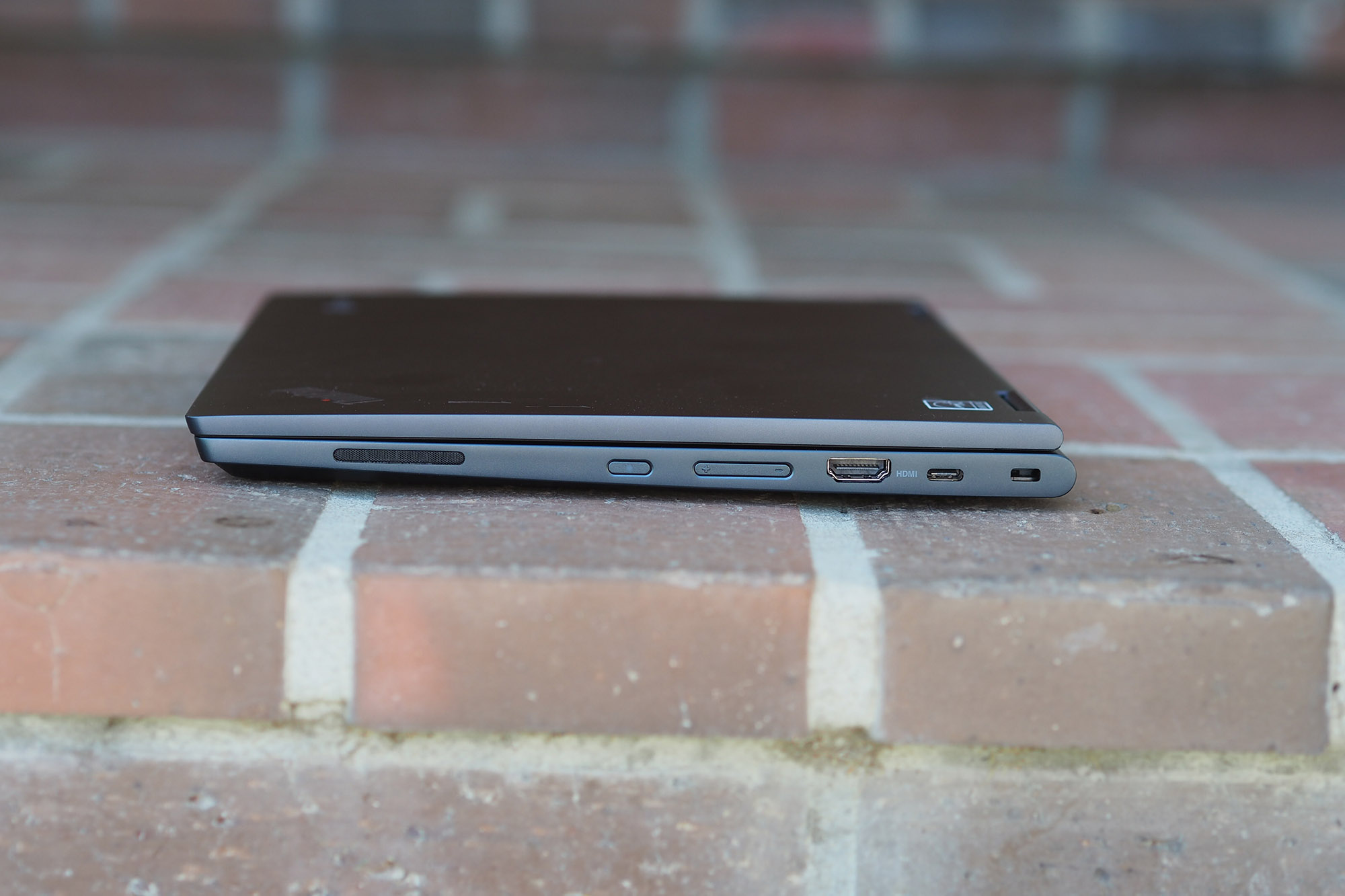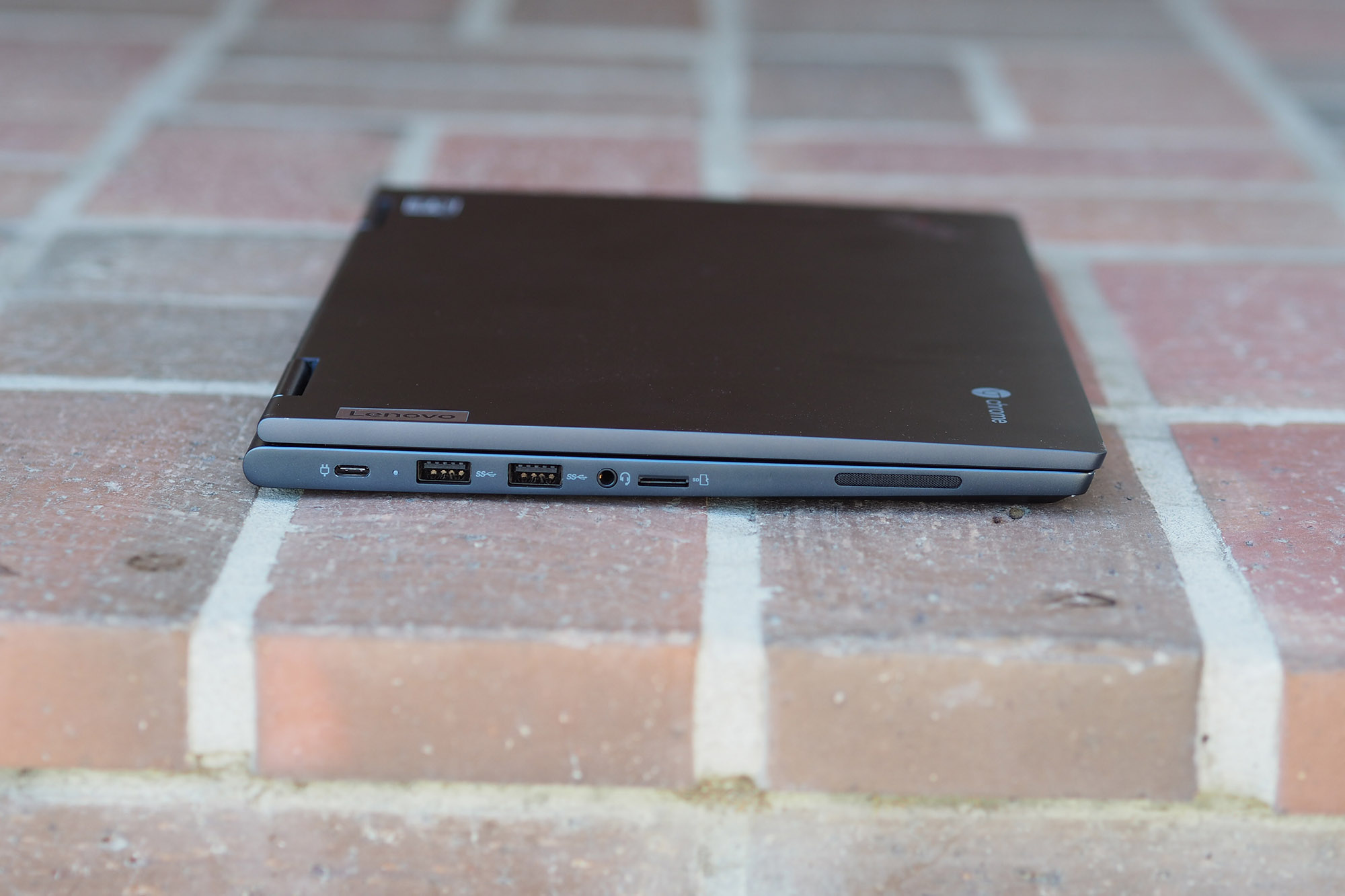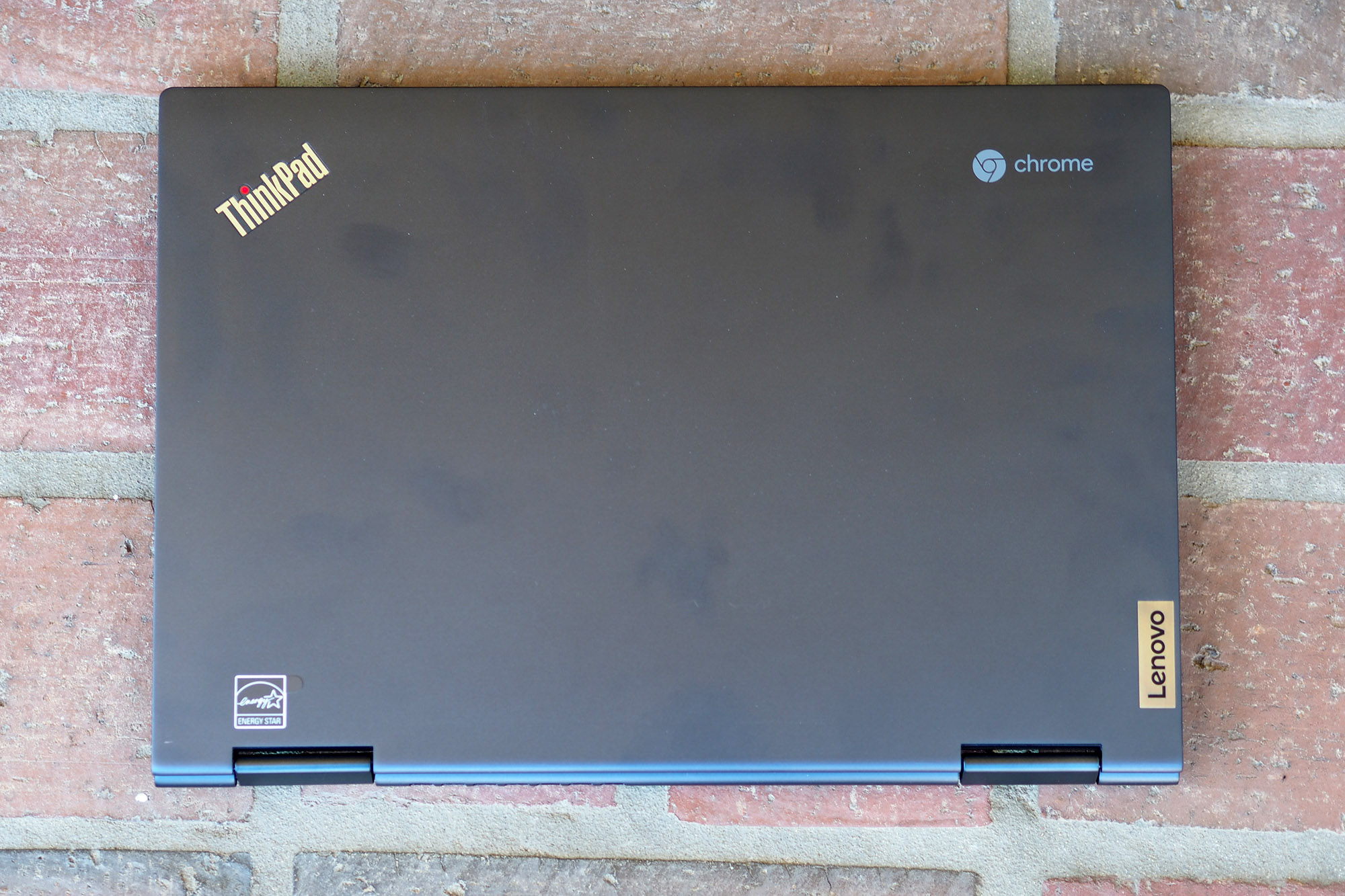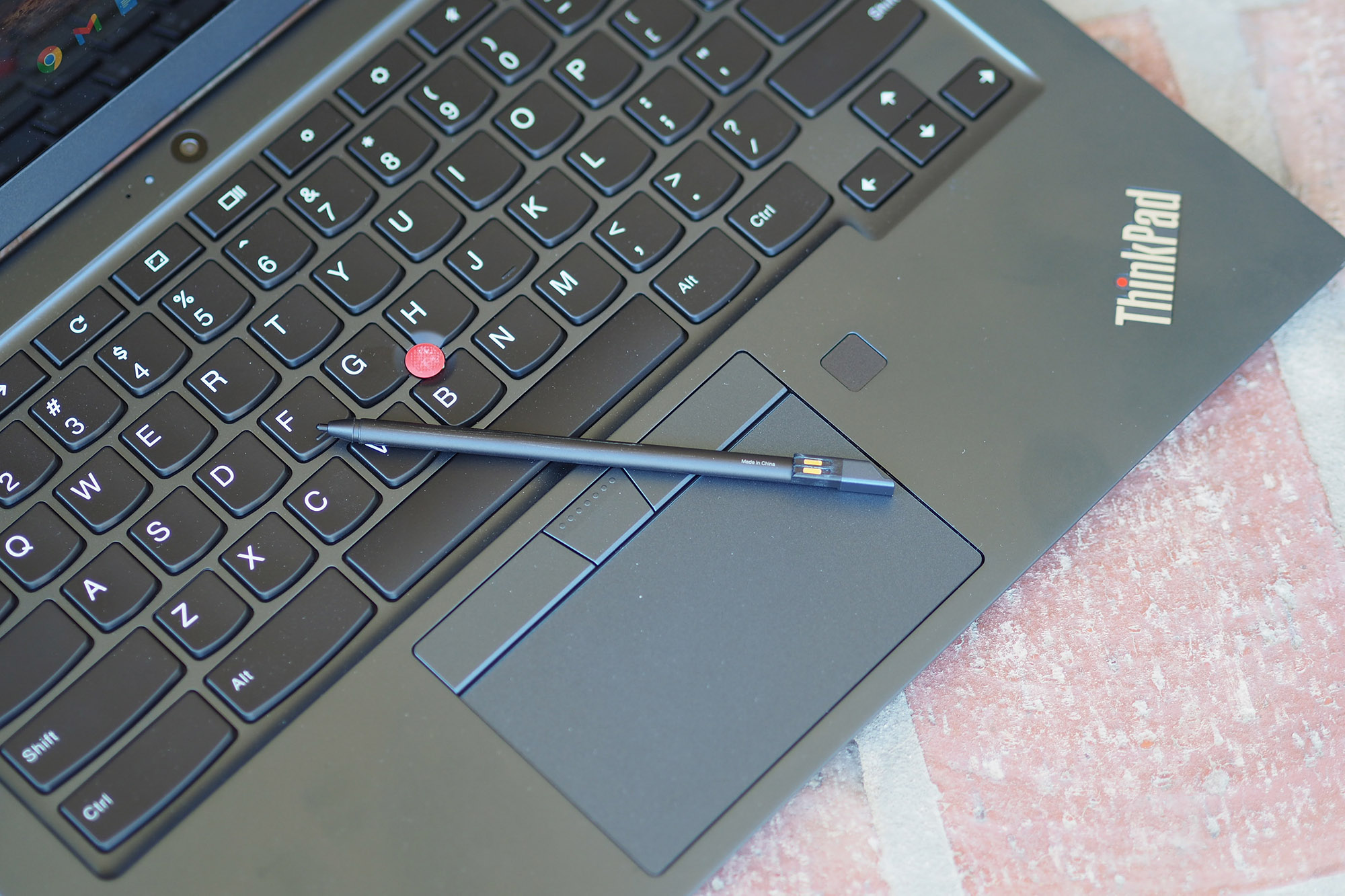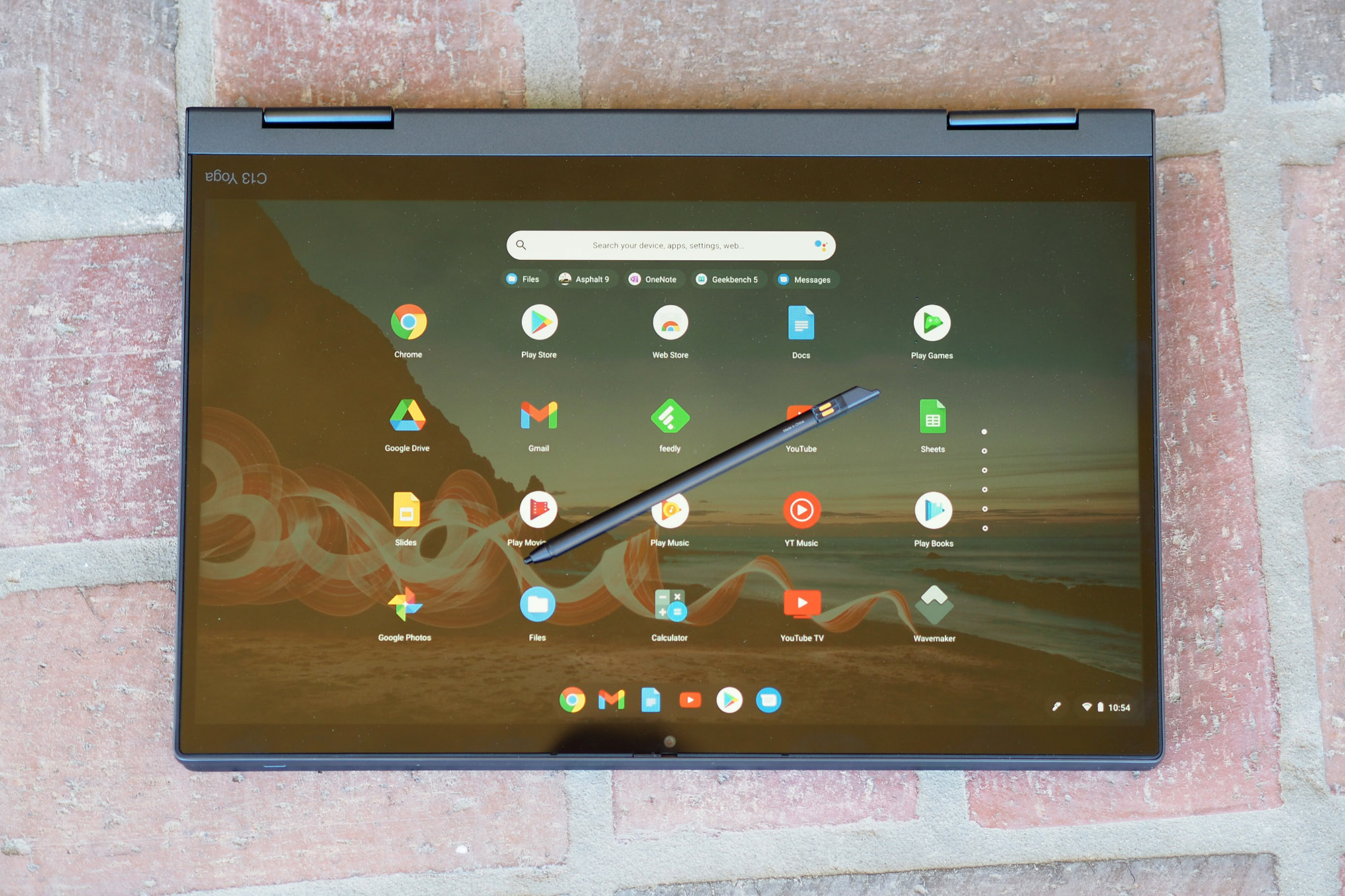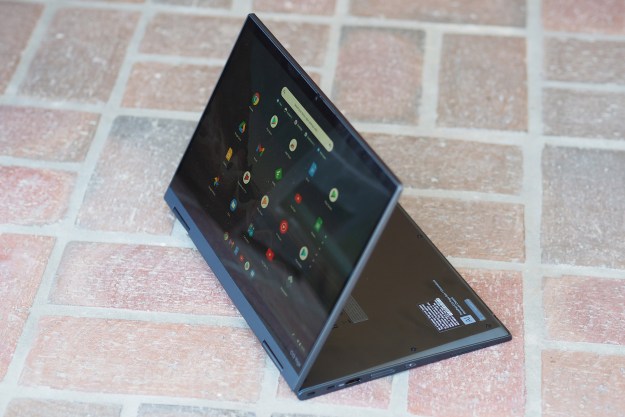
“The ThinkPad C13 Yoga Chromebook fits well into the enterprise, offering great security and manageability. But consumers should look elsewhere.”
- Solid build quality
- Good Full HD display
- Comfortable keyboard, touchpad, and pen
- Performance is strong
- Mediocre battery life
- Expensive
Chromebooks have made a name for themselves in the education world. In business, though? There’s still some work to do.
Part of the problem is a lack of high-end options for those who demand something with a premium finish. Bringing the popular ThinkPad brand to Chromebooks should do the trick, especially if you throw a powerful AMD Ryzen processor into the mix.
That’s the ThinkPad C13 Yoga Chromebook Enterprise, a long-winded name for a laptop that stresses security and performance for higher-end users.
My review unit was equipped with the new Chromebook-specific AMD Ryzen 5 3500C CPU, 8GB of RAM, a 256GB PCIe solid-state drive (SSD), and a Full HD (1,920 x 1,080) IPS anti-glare display. It also featured some add-ons, including a hybrid active capacitive pen and a 5MB world-facing camera, for a price after coupon of $859 ($1,321 as configured).
Do the extra security and specialized AMD processor give the ThinkPad C13 Yoga Chromebook a leg up?
Design
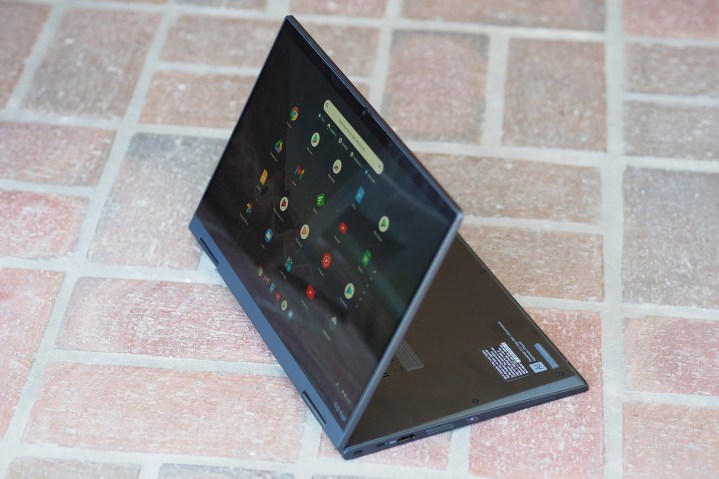
The ThinkPad C13 Yoga Chromebook follows the same general aesthetic pattern as the rest of the ThinkPad line. It’s all-black with just a few adornments (although the black isn’t quite as deep, looking more grayish) like the flashing LED “i” in the ThinkPad logo on the lid and the red accent on the keyboard provided by the TrackPoint nubbin.
Interestingly, Lenovo skipped the red stripes along the TrackPoint buttons, making the keyboard deck a bit plainer than usual. The chassis lines are also a little more complex than, say, the ThinkPad X1 Nano, with rounded backs on the bottom chassis and lid and a more swept-forward design.
It’s a good look for a Chromebook, and I find it more striking than the Dell Latitude 7410 Chromebook Enterprise, which is a fairly direct competitor — albeit the Latitude is a clamshell while the ThinkPad is a convertible 2-in-1.
Like all ThinkPads, the all-aluminum ThinkPad C13 Yoga Chromebook enjoys a robust build. There’s no twisting, flexing, or bending in the lid, keyboard deck, or bottom chassis, and the 2-in-1 evokes a great deal of confidence in terms of hauling it around. No need to coddle this laptop.
The bezels make the ThinkPad C13 Yoga Chromebook larger than it needs to be.
It’s easily the equivalent of the Latitude 7410 Chromebook. The ThinkPad C13 Yoga Chromebook is even as well-built as its Windows 10 competitors as well, including the HP Spectre x360 13 and the Dell XPS 13. I’ll note that the hinge is quite stiff, requiring both hands to open the lid, but it does hold the display in place through its four modes — clamshell, tent, media, and tablet.
One area where the ThinkPad C13 Yoga Chromebook falls behind is in its bezels. They’re thin along the sides but quite large on top and on the bottom, with a fairly massive chin. Some of the chin’s size is to accommodate the 2-in-1 hinge, but overall, it’s a far less modern look than the ThinkPad X1 Nano and the Dell XPS 13.
The Latitude 7410 Chromebook falls somewhere in between. The bezels make the ThinkPad C13 Yoga Chromebook larger than it needs to be as well. It’s bigger than the ThinkPad X1 Nano, although that’s not much of a surprise given that laptop’s smaller 13-inch 16:10 display, and it’s much larger than the Dell XPS 13 that sports a 13.4-inch 16:10 display.
It’s also slightly chunky at 0.70 inches thick, compared to the XPS 13 at 0.58 inches and the Spectre x360 13 at 0.67 inches. The XPS 13 and the Spectre x360 13 weigh 2.8 pounds, compared to the ThinkPad C13 Yoga Chromebook at 3.3 pounds. The Latitude 7410 Chromebook is 0.67 inches thick, even with its 14-inch display, and it weighs almost the same as the Lenovo at 3.36 pounds.
The ThinkPad C13 Yoga Chromebook incorporates a few features that will be of interest to enterprise customers. First, there are a few security features, such as the ThinkShutter slider that covers the webcam when you want to maintain your privacy and a fingerprint scanner that provides a secure (and quick and reliable, in my experience) way to log in without a password.
The Google H1 Security Chip works with Chrome OS to prevent software and firmware version rollback, log transitions between developer and normal modes, protect user encryption keys, and more. These features might also be attractive to consumer buyers, of course.
The 2-in-1 can also host Google Enterprise, which offers a host of resources to secure and manage a fleet of Chromebooks. Some of Google Enterprise’s capabilities include a managed Google Play Store that allows companies to regulate which apps users can install, Microsoft Active Directory integration, managed Chrome browser and extensions, single sign-on, and more. Google Enterprise is free to configure for the ThinkPad C13 Yoga Chromebook but brings with it a $50 annual fee.
The ThinkPad C13 Yoga Chromebook offers solid connectivity. Along the left-hand side of the laptop, you’ll find a USB-C 3.2 Gen 1 port, two USB-A 3.2 Gen 1 ports, a 3.5mm audio jack, and a microSD card reader. On the right-hand side are another USB-C 3.2 Gen 1 port and a full-size HDMI 2.0 connection. Wireless connectivity is up to date with Wi-Fi 6 and Bluetooth 5.0.
Finally, my review unit was equipped with an optional ($20) second camera at the top of the keyboard deck, a 5MP model that can be used as a world-facing camera in tablet mode. Choosing this option does reduce the number of microphones to just one from the dual microphones that are equipped without the 5MP camera add-on.
Performance

Lenovo chose AMD’s newest Ryzen CPU aimed directly at Chrome OS for the ThinkPad C13 Yoga Chromebook, in this case, the Ryzen 5 3500C. That’s the midrange CPU, sitting between the Ryzen 5 3250c and Ryzen 5 3700C. The CPU is a quad-core CPU with eight threads, running up to 3.7GHz. It’s actually an APU, with built-in AMD Radeon Graphics with eight graphics cores.
According to AMD, the Ryzen 5 3000C series offers double to triple the previous AMD Chrome OS offering’s performance, the Athlon A6 series.
The only benchmark in our suite that we can run on Chromebooks is Geekbench 5, and the ThinkPad C13 Yoga Chromebook scored 907 in the single-core test and 2,739 in multi-core. That’s very close to the 1,025 single-core and 2,712 multi-core scored by the Latitude 7410 Chromebook’s Intel 10th-gen Core i5-10310U.
The ThinkPad C13 Yoga Chromebook was plenty fast in everyday use.
That’s also about half the performance you’ll find with most Windows 10 laptops running Core processors, but of course, Chrome OS is far more lightweight than Windows 10 and doesn’t require nearly the processor performance to provide a good experience.
Likely thanks to the generous (for Chrome OS) 8GB of RAM and the speedy PCIe SSD, the ThinkPad C13 Yoga Chromebook was plenty fast in everyday use. I could open quite a few tabs and Chrome OS apps while running some Android apps in the background without any apparent slowdown. Like with the Latitude, the fans did spin up on occasion on the ThinkPad C13 Yoga Chromebook, but that’s not too high a price to pay for great performance.
I also played some games on the ThinkPad C13 Yoga Chromebook, including Asphalt 9, and found performance a little lacking. Asphalt 9, in particular, was surprisingly choppy. You’ll do fine with casual Android games, but GPU-intensive titles seem to stress the APU a little beyond its capabilities.
Display
I couldn’t test the ThinkPad C13 Yoga Chromebook’s 13.3-inch Full HD IPS display with my colorimeter, and so what follows are my subjective findings. Lenovo rates the display on my review unit at 300 nits of brightness, and I’d guess it comes close to hitting that number.
It’s an anti-glare screen as well, and so I didn’t find working in bright environments to be a problem — although I didn’t take it outside, where direct sunlight would likely prove too much for the display to overcome. Lenovo also offers a 4K display along with higher specs (16GB of RAM and a Ryzen 5 3700C CPU) for about $100 more.

Colors appeared nicely balanced without being oversaturated, and they seemed accurate enough. I compared some images with a few other color-accurate displays (such as the one on the Dell XPS 13), and they looked similar on the ThinkPad C13 Yoga Chromebook. I’d rate colors as good for a premium laptop, but I can’t say quite how wide the gamut is and whether it would work for creative types. The gamma also seemed spot on, with Netflix video looking neither too bright nor too dark.
The dual speakers were nothing to write home about. The audio was just average, with middling volume but no distortion. Highs and mids were clear, but there’s no bass to speak of. The audio is fine for videoconferencing and the occasional YouTube video, but for Netflix binging or tunes, I’d use a pair of headphones or a Bluetooth speaker.
Keyboard and touchpad
The ThinkPad C13 Yoga Chromebook’s keyboard is exactly like the one you’ll find on ThinkPad X1 Nano. That is, it has the same ThinkPad sculpted keycaps, the same spacing, and travel, and it’s even splash-proof thanks to liquid drain hole ducts on the chassis bottom.
As I used the two keyboards side-by-side, though, I noticed a slight difference with the mechanisms. The ThinkPad C13 Yoga Chromebook’s version was slightly less smooth in its action, bottoming out a little harsher than the ThinkPad X1 Nano’s.
Maybe these are the same keyboards and what I noticed was just a normal manufacturing variance, but I found the Chromebook’s version a little less precise. It’s a good keyboard, don’t misunderstand me, and better than the one on Dell’s Latitude 7410 Chromebook, but not as good as the one I enjoyed on the ThinkPad X1 Nano.
It’s also a step below the keyboards you’ll find on HP’s Spectre line and the Dell XPS 13, but a step above most (much less expensive) Chromebooks.
The touchpad is smaller than it could be, due to the two buttons supporting the usual ThinkPad TrackPoint nubbin in the middle of the keyboard. The touchpad’s surface was comfortable, and all the usual Chrome OS multi-touch gestures worked well.
The TrackPoint also worked as well as it does on other ThinkPads, providing another way to control the cursor for those who like that kind of thing.

The touch display was responsive and precise as well. Lenovo includes a docked hybrid “active capacitive” pen that doesn’t need an active layer, making the display thinner and less complex.
The pen support 2,048 levels of pressure sensitivity, and I found it to work fine for doodling and the occasional handwritten note. Chrome OS doesn’t provide the same inking support as Windows 10, but what support there is worked fine with the optional pen (a $44 add-on).
Battery life

Lenovo packed in 51 watt-hours of battery life into the ThinkPad C13 Yoga Chromebook’s chassis, and that’s a fair amount for a 13.3-inch Full HD machine. We don’t have any other experience with the AMD Ryzen 5 3500C, so I looked forward to seeing how long the 2-in-1’s battery would last.
In our web browsing test, which loops through a series of popular websites, the laptop lasted for 7.25 hours, which is about 40 minutes less than both the Dell Latitude 7410 Chromebook and the Lenovo Chromebook Flex 5 with an Intel Core i3-10110U.
As the best measure of the laptop’s productivity longevity, that promises nearly a full day’s work but not quite. It’s considerably less than many recent Windows 10 laptops that last for a couple more hours.
Many Chromebooks last far longer in battery life.
Looking at our video test that loops through a Full HD Avengers trailer, the ThinkPad C13 Yoga Chromebook lasted for about 7.5 hours. That’s two hours longer than the Latitude 7410 Chromebook but not very competitive with the Windows 10 field, where 10 hours or longer is the norm.
Finally, I ran the 2-in-1 through our most demanding test, the Basemark web benchmark (which won’t run on Intel’s Tiger Lake laptops, for some reason), and it lasted for almost exactly three hours. That’s an average score but again 40 minutes less than the Latitude 7410 Chromebook.
Overall, I found battery life to be a disappointment. Many Chromebooks last far longer thanks to the general efficiencies of Chrome OS. So either the AMD CPU isn’t very power efficient, or Lenovo tuned it more for performance than battery life. Either way, you’ll want to carry your power adapter with you for longer working days.
Our take
The ThinkPad C13 Yoga Chromebook has a target demographic, and for that audience, it has its strengths. However, it isn’t the best performing Chromebook we’ve used, nor is it the longest-lasting on a single charge of the battery. It’s well-built like ThinkPads always are, and it takes on the Latitude 7410 Chromebook — the other Enterprise Chromebook we’ve reviewed — with the extra flexibility of a convertible 2-in-1.
But being Google Enterprise-eligible is the ThinkPad C13 Yoga Chromebook’s only true claim to fame. That explains the relatively high price — which is far beyond what a typical Chromebook buyer should pay.
Are there any alternatives?
We’ve mentioned the Dell Latitude 7410 Chromebook a few times, and it’s a comparable machine outside of being a clamshell. It’s also significantly more expensive, coming in at $1,900 for a machine with a Core i5, 16GB of RAM, a 256GB SSD, and a 4K display.
You could also consider the HP Pro c645 Chromebook Enterprise when it’s eventually released, and the Acer Chromebook Enterprise Flip 13 is available today and offers the same Google Enterprise features in a 2-in-1 format for $1,300 — although you’ll only get an 8th-gen Core i7 CPU. You’ll probably appreciate the 3:2 display at 2,256 x 1,504, however.
If you don’t need the enterprise features, you’ll probably be looking hard at the Google Pixelbook Go, our choice as the best Chromebook you can buy. It’s less expensive as well, but it’s also consumer-only, and so enterprise buyers will want to consider one of the other machines in this list of alternatives.
How long will it last?
The ThinkPad C13 Yoga Chromebook will last for years thanks to its robust build, and its components should keep Chrome OS humming along for just as long.
The one-year warranty is disappointing for an enterprise-class laptop, however.
Should you buy it?
For the average Chromebook buyer, no. It’s a decent option for Chromebook enterprise users, but there are better Chromebooks for the average person out there.
